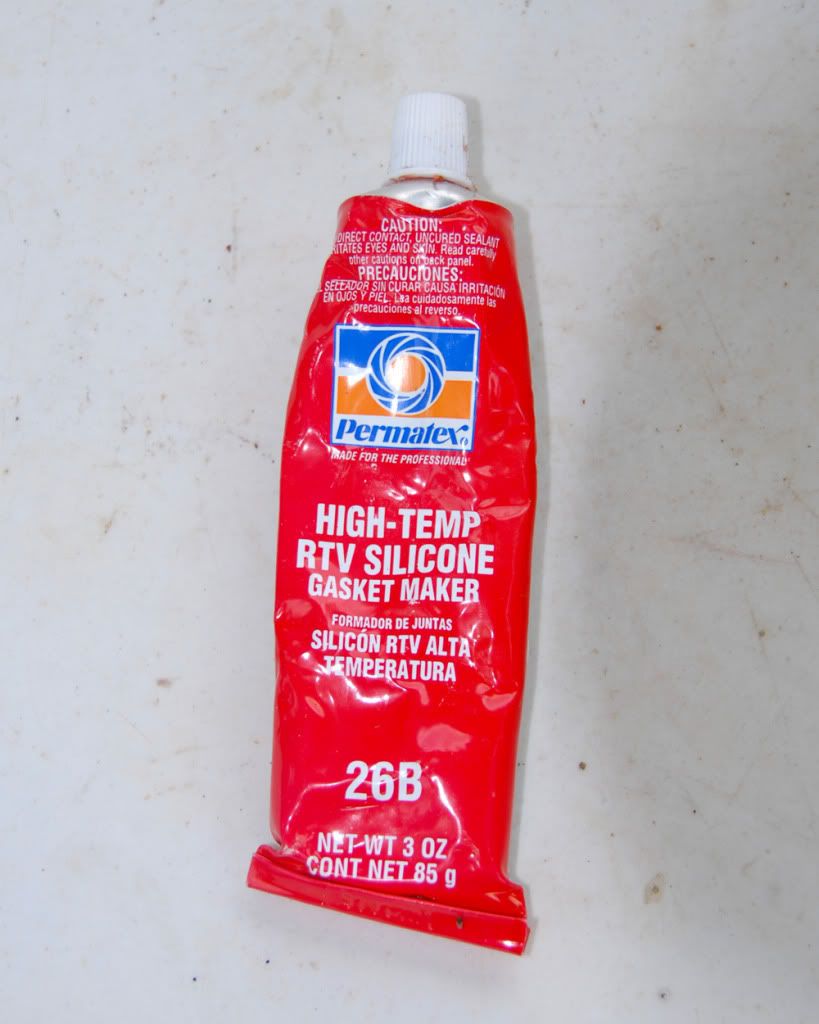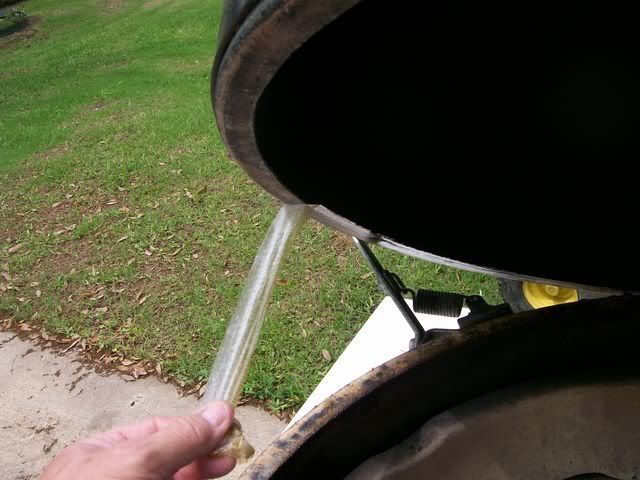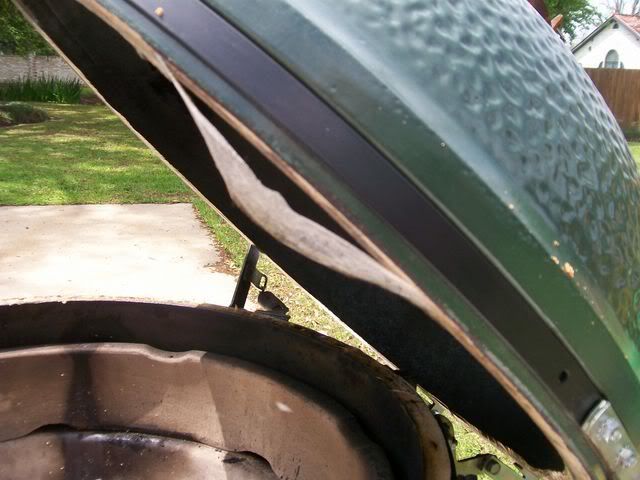Welcome to the EGGhead Forum - a great place to visit and packed with tips and EGGspert advice! You can also join the conversation and get more information and amazing kamado recipes by following Big Green Egg to Experience our World of Flavor™ at:
Want to see how the EGG is made? Click to Watch
Facebook | Twitter | Instagram | Pinterest | Youtube | Vimeo
Share your photos by tagging us and using the hashtag #BigGreenEgg.
Share your photos by tagging us and using the hashtag #BigGreenEgg.
Want to see how the EGG is made? Click to Watch
Gasket Failure
Grandpas Grub
Posts: 14,226
Lost another gasket on my egg. Number 10 and counting. To be fair a small number of the failures were due to my gasket testing and I have no way of knowing how they would have held up under normal use.
This was an interesting failure and actually an adhesive failure. The gasket had been on the egg from early to mid last summer to now. The gasket looked very good with a lot newish gray color showing. A very good pull on the dollar bill test all the way around the egg. Very seldom has this egg been above 500° and never over 400° or any length of time until yesterday. I wanted to do a clean burn so I took the egg to 500° - 525° for 2 to 3 hours. I noticed the chimney was getting somewhat light gray in color and decided to look inside to see how the innards were looking.
As I opened the dome a 10” piece of gasket simply stayed on the base rim. Now this particular gasket was purchased well before BGE had the last run of bad adhesive. After seeing I had an adhesive failure I opened the dome fully and began to remove the remaining material on the dome side of the egg. The gasket came off in one piece and still looks fairly serviceable.
The adhesive looked very much like an old piece of yellowed Scotch Tape. Just after pulling the gasket off I decided to remove the remaining adhesive “tape” from the gasket itself. For the most part the adhesive pulled of like a strip of tape. There were a few spots I had to use my fingernail to lift up and then pull the adhesive off.
The adhesive tape had little to no tackiness to it just after I pulled it off of the egg & gasket itself. However, after 20 minutes and a complete cool down to ambient temperature the adhesive itself again was tacky.
Just before I pulled the remaining gasket material off of the dome I checked the bottom gasket to see how loose it was. I could have pulled it off just as easily as the top gasket. I decided to leave the bottom gasket material alone. Now that the egg has cooled down the bottom gasket again feels tight against the ceramics. To remove it now I would have to use a scraper and alcohol.
I have some 3M membrane adhesive that I am going to try using to hold the top gasket. Stike keeps saying the 3M Supper 77 is just rubber cement. If the 3M membrane fails I am going to try using some rubber cement to see how that works. Should that fail I think I am going to take Ranger Ray’s advice and use the silicone to make my own gasket material.
GG
This was an interesting failure and actually an adhesive failure. The gasket had been on the egg from early to mid last summer to now. The gasket looked very good with a lot newish gray color showing. A very good pull on the dollar bill test all the way around the egg. Very seldom has this egg been above 500° and never over 400° or any length of time until yesterday. I wanted to do a clean burn so I took the egg to 500° - 525° for 2 to 3 hours. I noticed the chimney was getting somewhat light gray in color and decided to look inside to see how the innards were looking.
As I opened the dome a 10” piece of gasket simply stayed on the base rim. Now this particular gasket was purchased well before BGE had the last run of bad adhesive. After seeing I had an adhesive failure I opened the dome fully and began to remove the remaining material on the dome side of the egg. The gasket came off in one piece and still looks fairly serviceable.
The adhesive looked very much like an old piece of yellowed Scotch Tape. Just after pulling the gasket off I decided to remove the remaining adhesive “tape” from the gasket itself. For the most part the adhesive pulled of like a strip of tape. There were a few spots I had to use my fingernail to lift up and then pull the adhesive off.
The adhesive tape had little to no tackiness to it just after I pulled it off of the egg & gasket itself. However, after 20 minutes and a complete cool down to ambient temperature the adhesive itself again was tacky.
Just before I pulled the remaining gasket material off of the dome I checked the bottom gasket to see how loose it was. I could have pulled it off just as easily as the top gasket. I decided to leave the bottom gasket material alone. Now that the egg has cooled down the bottom gasket again feels tight against the ceramics. To remove it now I would have to use a scraper and alcohol.
I have some 3M membrane adhesive that I am going to try using to hold the top gasket. Stike keeps saying the 3M Supper 77 is just rubber cement. If the 3M membrane fails I am going to try using some rubber cement to see how that works. Should that fail I think I am going to take Ranger Ray’s advice and use the silicone to make my own gasket material.
GG
Comments
-
Kent - Next time, use this:

-
Thanks, I was debating using the the Hi-Temp Silicone. Sine mid '08 I have been wanting to try the 3M membrane and also the rubber cement idea.
For the last long while I have had really good luck with the felt gasket material. This failure and the way it happened really surprised me.
Kent -
I used permatex on my current gasket and it looks like its never coming off : )
-
Man, your going threw a lot of gaskets. My gaskets are good but I'd like to play with some silicone on my 'Baker' egg just to see what would happen.
Just an idea, if you go silicone there's black silicone as an option to the red stuff. Black would look better I would think. Permatex makes it and so does Versa Chem from an automotive supply store. Rated to 500 degrees. The Versa Chem Automotive Black RTV Silicone, Type 270, is less expensive than Permatex but looks to be the same. I think Permatex Red is rated to 650 degrees, not sure.
I'm thinking of forming a gasket on the base rim, nothing on the top rim, about 1/8" thick, 1" wide.
Anyway, just wanted to share with you that there is a black silicone option. -
Kent, Are you going to clean it up and install a new gasket before winter sets in? I know a great person that has excellent pic's on how to clean the base and dome for a new gasket. :woohoo: He may even do it for you!
 Tim
Tim -
Once I give the two options I mentioned above a try I will probably try the permatex/Nomex (or generic) a try or maybe just go to the permatex.
I need to check with him, but, I think Ranger Ray just used silicone only. I am not sure how Ray uses his egg(s) as far as temperature goes. If I recall his silicone gasket has lasted 5 or 7 years now. At Lowes I saw a 35 year silicone, which would stand up to UV, rain, water, mold and on and on. I have no idea if any of this stuff is food safe or what temperature rating it has. I think I will lay out a bead of some of the items an run the MAPP over it just to see what happens.
Unless BGE comes up with something better. I will probably end up using silicone or permatex only. I have had really good luck with the old style felt, it is just that darn adhesive.
Kent -
:laugh: Very funny. - So when are you coming over!
What is a little surprising is that the gasket and adhesive 'tape' came of very clean. From the way it looks I will only need to give the surface a quick wipe down before putting the gasket back on.
I need to look at the gasket a little more closely but I am thinking of reinstalling the same gasket with the new 3M membrane adhesive.
Somewhere in the BGE literature they say to use Elmer's glue.
Kent -
I hear ya. There are alternative adhesives and I think your ready to try one. I would think silicone is safe if it's not burning. ..."if"... is in question though.
Well it's a problem and I enjoy problem solving and I think you do also.
Let us know what you decide to do, we are interested. -
Kent, I need to replace the top gasket on my Mini. Are you saying/suggesting that Elmer's glue might be as good as or better than the alternative adhesives? I read the Elmer's glue reference in the "owner's manual/cookbook". I never really took it seriously.
-
Your description is identical to the failure I had a couple years ago with a nomex replacement on my XL and felt on my second cook on my mini. Rutland on the base of the XL, Small, and Mini now - nothing on the dome


-
The last gasket I replaced was a Rutland using Rutland high temp silicone sealant that comes in a big tube for $6. I am 100% impressed with the holding power and have had my egg up to 700 degree numerous times even though the silicone is rated for 500. I previously tried Super 77 and the black Rutland cement with failure after failure. The silicone adheres to the egg and gasket well. Regardless of the gasket material, I would use silicone for the adhesive.
-
Frank,
I'm with you. A naked dome is a great way to fly. -
just to clarify. i think i may have said at different times both that the the Super 77 is rubber cement and/or contact cement, which may be incorrect (whah? stike actually said he might be incorrect?! hahah). so here's the rub, i'm not sure what the huge difference is between "contact" and "rubber" cements
basically, Super77 is natural latex rubber that is thinned enough to spray, and contains the propellants of course that allow you to spray it. when the propellants and thinning solvents evaporate, you end up with latex rubber glue on whatever surface.
i don't recall if rubber cement is supposed to dry (surface no longer tacky) before you glue the two surfaces together. i just know that the 77 and rubber cement are both essentially the same latex rubber. might be different formulations?
but perhaps contact cement is more closely similar to how the super 77 is to be used. for both, the strongest adhesion is achieved by applying to both surfaces and allowing it to dry.
if i were standing in the store with a bottle of rubber cement (like for paper crafting) and contact cement, i'd buy the contact cement first.
i gotta think the guys applying the gaskets in the factory aren't using super 77. there's the masking, the frikkin nose hairs and arm hairs ticking together (i have inhaled my fair share over the years!), and the relative expense. i'd bet my tightie-whities that they have a jar of contact cement and they brush the rim and stick the gasket into it. some on the gasket also? i dunno. i wonder if it is so hairy and would work into the cement that you could probably just do the rim
he said, trying not to overthink it.... hahaha -
No, I am saying BGE suggested Elmer's Glue. I had the same thoughts when I read it on the gasket replacement kit I bought.
I do wonder if it would work though. I also wonder the tolerance to the heat. I don't see me using the Elmer's solution.
Kent -
Kent, I would like to tell you a story about Elmer's glue from my youth. As a mischievous young boy in grade school while sitting at my desk on a Friday I opened the my desk top and took out the Elmer's glue and filled my pencil holder full of the white stuff. :evil: When I come back on Monday the glue had hardened clear as I pried it out of the dip where pens and pencils go it took some paint off the desk with it and was semi ridged yet semi pliable. I was always into something. Just sayin. Tim
-
hehehe, sure glad I never did anything like that.
Thinking of some woodworking projects the Elmer's glue never seemed to release with out taking some stock form one side and or the other.
The ceramics are somewhat pours as is most of the gasket material. Elmer's might not be such a bad idea.
Several years ago when thinking of the high temp. gasket adhesives (and other adhesives) I was concerned about getting the stronger adhesives off of the egg surface. I sure wouldn't be wanting to be pulling ceramic chips/chunks off of the dome or base.
Kent -
In the first picture I can see there took some pull. However, the second picture, although longer lengths for me, was what it looked like. The adhesive was somewhat holding on to the felt side. The adhesive on mine was yellow - that old scotch tape look.
Kent -
Grandpas Grub wrote:
...I sure wouldn't be wanting to be pulling ceramic chips/chunks off of the dome or base.
Kent
I would not either. :( -
It has been shown over and over by a lot of people that the Rutland is durable. As I recall there has only been one post showing a Rutland holding failure.
It seems to me that the ceramics make a great heat sink for the gasket/adhesive. When the dome is at 700° I wouldn't expect the gasket or adhesive to be anywhere near that temperature.
I had my medium at 650° and used an IR thermometer to read the temperature of the ceramics on the inside of the egg about 1/2" above and below the gasket. As I recall the temperature was about +/- 360°.
I think you are right about the silicone.
GG -
I have no idea if this is factual, however, in a post or via email I read that BGE has a supplier that puts the adhesive on the gasket material for them - which would make sense.
(before I continue with this comment I better stress this is said with jest) - "i think i may have said at different times both that the the Super 77 is rubber cement and/or contact cement, which may be incorrect".
I would never even consider the possibility. (done with the in jest part).
You work with this type material all the time which would lead me to believe you know something about the stuff.
Kent
Categories
- All Categories
- 184K EggHead Forum
- 16.1K Forum List
- 461 EGGtoberfest
- 1.9K Forum Feedback
- 10.5K Off Topic
- 2.4K EGG Table Forum
- 1 Rules & Disclaimer
- 9.2K Cookbook
- 15 Valentines Day
- 118 Holiday Recipes
- 348 Appetizers
- 521 Baking
- 2.5K Beef
- 90 Desserts
- 167 Lamb
- 2.4K Pork
- 1.5K Poultry
- 33 Salads and Dressings
- 322 Sauces, Rubs, Marinades
- 548 Seafood
- 175 Sides
- 122 Soups, Stews, Chilis
- 40 Vegetarian
- 103 Vegetables
- 315 Health
- 293 Weight Loss Forum